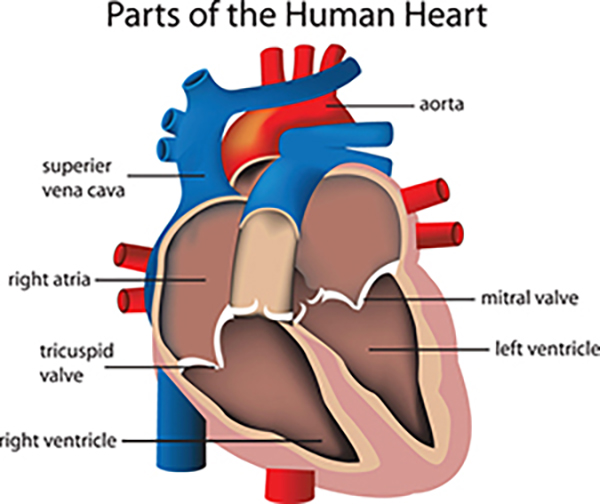Learn
Location of the Heart
Your heart is a muscular organ about the size of your fist that lies within the pericardial cavity of the mediastinum.
See the image below showing the heart’s location between the lungs in the thoracic cavity.

Your heart’s job is to pump blood through the body. It does this through a cycle of contraction and relaxation called the
cardiac cycle series of myocardial contractions and relaxations that make up one heartbeat .
Go to Cardiac Cycle to view a computerized animation of a heartbeat in action.
Check your understanding...
Which of the following structures functions as a pump in the CV system?
a. blood
b. blood vessels
c. heart
d. cardiac cycle
Answer: heart
Structure of the Heart
Your heart is divided into a left and right side. It is also composed of 4 hollow chambers allowing blood to travel through as it is pumped by the heart.
Each chamber has a one-way valve that helps maintain a forward direction of blood flow.
The image below is a picture of a real human heart taken during an autopsy.

The next image is a coronal section of the heart illustrating the chambers and valves.
Take a moment to find these structures.

Look at another image of the heart labeled with abbreviations.
Take a moment to identify the 4 chambers and 4 valves.

Your heart is also covered by a membrane called the pericardium. Look at the image below showing the pericardium cut and pulled back.

This membrane has 2 layers:
An inner layer - a double-sac that contains serous fluid a lubricating fluid functioning to decrease friction during the heart’s beating movement
An outer layer - composed of connective tissue stabilizing the heart within the cavity
Check your understanding...
How many chambers are found in the heart?
Answer: 4
How many valves are found in the heart?
Answer: 4
As shown in the images, which chambers are found on the right side of the heart?
Answer: right atrium and right ventricle
As shown in the images, what is the name of the valve found between the left atrium and left ventricle?
Answer: Mitral Valve
What is the function of the serous fluid?
Answer: lubricate the heart to decrease friction as it moves when contracting
Overview of the Heart
The mechanical system = the moving structures such as valves and muscle
The electrical system = the electrical part or the conduction system where cells depolarize
The plumbing system = the parts where blood travels, such as inside the chamber and within the coronary arteries
View this PBS Learning Network video on The Heart to get started learning.PBS login information.
